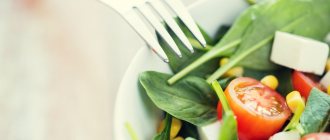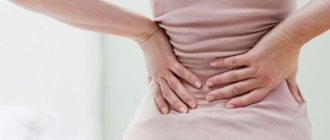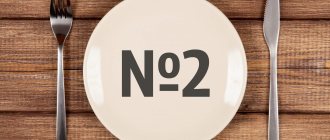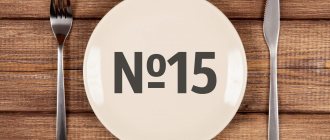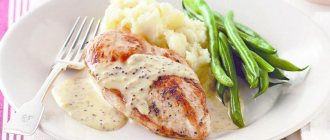Constipation or coprostasis is a delay in bowel movement for more than two days. In another interpretation, it includes the daily excretion of feces, but in a very small volume (less than 100 g).
It is rare for an adult to experience such a frequency of stool without unpleasant or painful sensations or a general disturbance of well-being. The problem arises of how to eat with constipation if the intestines are clogged. Questions about proper nutrition are increasingly of interest to residents of developed countries, wealthy people who have the opportunity to choose products.
According to statistics, they prefer fatty foods, sweet drinks, a lot of coffee, do not pay attention to the presence of fiber in vegetables and fruits in their diet, are addicted to fashionable diets, and do not exercise much. A diet for constipation is formed after identifying the causes and excluding the influence of diseases with pathology of the digestive organs.
What diseases cause constipation?
The bolus of food moves through the intestines due to contractions of the muscle layer. The colon is of particular importance in the formation and removal of waste from the body. With the help of wave-like contractions (peristalsis), it ensures motility and movement of feces into the rectum.
Violation of this function is possible in a spastic or atonic type:
- During spasm, peristalsis is enhanced, muscle tone is increased, areas with a narrowed lumen appear, up to the development of intestinal obstruction. Clinically, it manifests itself as severe abdominal pain, vomiting, and uneven bloating. In such cases, food is prohibited and urgent surgical measures are necessary.
- Atonic coprostasis - is caused more often in older people due to the lack of “response” of the intestinal muscles to stimulating signals coming along the nerve trunks. The intestines lose their ability to contract.
The type of constipation can be suspected by symptoms
Constipation occurs as one of the serious symptoms of intestinal lesions due to inflammation (colitis), pain due to hemorrhoids, rectal fissures, proctitis, diseases of the stomach, liver and gallbladder, congenital anomalies (dolichosigma, megasigma).
If the examination reveals a disease, then a diet for constipation in adults is considered as one of the components of therapy. Patients must take into account the requirements for compliance with the use of foods that weaken the intestines no less seriously than taking laxatives and other drugs.
Consequences of not following the diet
Without nutritional correction, isolated cases of constipation develop into chronic constipation. At the same time, the symptoms of this disorder worsen and the risk of complications increases, the most common of which are [15]:
- Hemorrhoids (Fig. 1).
- Anal fissures.
- Rectal bleeding.
Inflammation of the mucous membrane of the rectum and sigmoid colon - proctosigmoiditis.
Figure 1. Stages of development of hemorrhoids. Source: CC0 Public Domain
What should a doctor find out before prescribing a diet?
In the absence of any pathology in the patient, it is important to find out the type of diet, preferences, regularity and frequency of meals. The fact is that intestinal peristalsis is subject to functional disruptions in the case of irregular nutrition, dry snacks like sandwiches and hamburgers without first courses, long periods of hunger followed by overeating.
Coprostasis is caused by inappropriate choice of foods and dishes. A significant amount of fats and proteins (fatty meat, confectionery), light carbohydrates (sweets) slow down the digestion of food starting from the stomach. A small amount of raw vegetables, fruits, fiber (dietary bread made from wholemeal flour, bran, cereals), lack of drinking water do not include substances that stimulate peristalsis in the digestion process.
The reflex mechanism of urges is disrupted by frequent restraint in the absence of a toilet nearby, a “sedentary” lifestyle, and fasting for weight loss and cleansing. Constipation with a diet of this kind is associated with a change in the contents of the intestines, feces acquire a hard, rocky consistency, and its elimination is difficult.
Sometimes the doctor finds out the influence of stress, pregnancy in women, low adaptability to a new environment, these reasons aggravate stagnation of feces and can subsequently lead to serious illnesses
Constipation concept
The norm is considered to be daily formed stool in a person. Constipation is usually understood as a delay of 3 or more days, a difficult process of defecation with the release of up to 100 g of feces. In the medical literature there are several names for this pathology - coprostasis, constipation. It can be a consequence of illness or errors in diet, a side effect of taking certain medications, or accompany pregnancy.
Standard table No. 3 and its purpose
Diet No. 3 (according to Pevzner) is recommended for patients with diseases or physiological conditions accompanied by constipation. It is indicated for people with a lack of physical activity, with forced long-term bed rest, if the disturbances are caused by climate change, moving, or pregnancy.
It is important to consider that against the background of exacerbation of chronic diseases of the stomach and intestines, you cannot use diet No. 3 for constipation. It includes many irritating factors, which will have a harmful effect on the inflamed organs. Diet objectives:
- strengthen peristaltic contractions of the intestine;
- balance the effects of bile acids;
- “extinguish” the processes of fermentation and decay.
The patient should have regular bowel movements and bloating should disappear. General table rule No. 3 is to eat less than three kg of food per day, drink 1.5 liters of water or more (if there are no restrictions due to the condition of the kidneys or the cardiovascular system). Eating for constipation in adults does not require mechanical grinding of food.
You can eat five times a day, the frequency should be distributed approximately every 4 hours. This is important for bowel function. A positive aspect of the table is the general availability of products, the opportunity for patients with average incomes to fulfill the requirements for a long time with effective results, and individually choose the most suitable ones.
Some nutritionists consider the contraindication of milk to be a disadvantage. Others consider compensation through fermented milk products to be quite sufficient. There are no restrictions on the amount of protein, fat and carbohydrates required. Calorie intake on some days can be reduced for obese patients in consultation with the doctor.
It is recommended to train yourself to drink half a glass of water 30 minutes before meals and an hour after
General rules
Daily bowel movements (every day in the morning) are the norm, and deviations from this rule are constipation or coprostasis - stool retention for more than 2 days or regular difficult bowel movements with the release of up to 100 g of feces.
However, we can proceed from the general condition of a person - if he does not experience discomfort in the absence of daily bowel cleansing, then the frequency of stool once every 2 days can be considered normal. Nevertheless, it is worth trying various methods to normalize intestinal function. Difficulty emptying often occurs with diseases of the intestines ( colitis , hemorrhoids , proctitis , fissures, dolichosigma , megasigma ), stomach, and liver. In this case, the motor function of the colon is impaired. Slowing down the passage of contents occurs according to a spastic or atonic (hypomotor) mechanism.
With spastic coprostasis, peristalsis is enhanced due to retrograde (unnatural) peristaltic waves, and the intestinal lumen narrows. As a result of a significant increase in muscle tone, intestinal obstruction may develop. It begins with a sharp, cramping pain in the abdomen, which gradually increases and is accompanied by nausea and vomiting. Constipation and gas formation occur. After some time, the contents of the intestines enter the stomach and the vomit acquires an unpleasant smell of feces. The abdomen has an irregular shape and bloating rapidly increases. Atonic coprostasis occurs 2 times less often and dominates in older patients and in some cases complete intestinal atony manifests itself.
In the absence of diseases, irregular bowel movements are caused by:
- Lack of raw vegetables and fruits, coarse fiber (brown bread and cereals) in the diet, which deprives the body of peristalsis pathogens. Animal fats and proteins do not force the colon to “work” and lead to intestinal atony. Eating sandwiches, hamburgers “on the run” and the absence of first courses in the diet is also of no small importance.
- Lack of fluid.
- Sedentary lifestyle.
- Regular control of urges.
- Starvation. Defecation in the first days of fasting can be regular, and then intestinal activity is absent to one degree or another. After fasting, due to prolonged retention of feces in the intestines, it becomes hard and peristalsis is sluggish, which makes it difficult to empty it.
- A change of scenery.
- Pregnancy.
- Prolonged stress.
When starting treatment, you need to find out the cause of constipation and, first of all, try to eliminate it with nutrition. If there is no bowel movement for 2-3 days, and eating laxative foods does not help, you need to cleanse the intestines by doing a 1-liter enema. To prevent feces from injuring the mucous membrane, add 2-3 tbsp to the water. l. vegetable oil. The water temperature should be room temperature and not necessarily boiled. After this, you need to start eating right.
What diet is prescribed for chronic colitis with constipation and what goals does it serve? For colitis without exacerbation, Table No. 3 , which allows you to normalize impaired intestinal function. It is a physiologically complete diet with a predominance of dietary fiber - vegetables, fruits, dried fruits, cereals. The diet includes cold first courses and sweet dishes. At the same time, products that increase fermentation and rotting (fried foods) are excluded.
Food is prepared in uncut form, boiled or baked. Vegetables are recommended mainly raw and some of them boiled. Eating 4-5 times a day. It is important to maintain a drinking regime - 1.5-2 liters of fluid per day. This is explained by the fact that when there is a lack of fluid in the sigmoid colon, water is absorbed from the feces and they become hard, which makes it difficult for them to pass through the anal canal.
Diet for constipation in adults
Nutrition for constipation in adults associated with intestinal atony is aimed at enhancing its peristalsis. Thus, a laxative diet includes foods that relieve constipation.
Diet for constipation in older people. Such products include:
- Rich in sugars - jam, cane sugar, syrups, honey, milk sugar, dextrose, mannitol, levulose, sweet dishes. They attract fluid into the intestines and thin the stool.
- Containing salt - salted fish, salted vegetables, canned snack foods.
- With a high content of organic acids - pickled and pickled vegetables, sour fruits and juices from them, fermented milk drinks, fruit drinks, which stimulate peristalsis.
- Rich in dietary fiber - bran, legumes, dried fruits, nuts, wholemeal bread, millet, barley, buckwheat, pearl barley, oatmeal, raw vegetables.
- Meat with a high content of connective tissue.
- Drinks containing carbon dioxide.
- Fats consumed on an empty stomach in large quantities (1-2 tbsp), sour cream and cream (100 g or more), egg yolks.
- Cold dishes (150 C), consumed on an empty stomach or for lunch - okroshka, beetroot soup, cold jellied dishes, as well as all cold drinks and ice cream. It is the difference in body temperature and the product taken that is the main factor in stimulating peristalsis.
- Kumis and kvass, which have a double effect: due to the content of organic acids and carbon dioxide.
- Fiber, bran and seaweed tend to swell in the intestines and attract water.
- Sauerkraut is a source of organic acids and fiber.
In parallel with this, it is necessary to exclude foods that delay bowel emptying: black coffee, strong tea, cocoa, chocolate, soft cheeses, lingonberries, blueberries, dogwood, pomegranate, pears, mucous soups, pasta, jelly, hot dishes, red wine. These are general principles of nutrition for constipation in adults. When choosing a diet, you should also take into account concomitant diseases of the digestive system:
- If constipation occurs against the background of exacerbation of chronic intestinal diseases, the gentle Table No. 4B , and then No. 4B . They exclude coarse fiber and include non-coarse peristalsis stimulants (cold sweet drinks on an empty stomach, vegetable juices, pureed beets, plums, carrots, cauliflower with the addition of vegetable oil, baked apples, kefir).
- For liver diseases with constipation Diet No. 5 , but with an increase in dietary fiber and magnesium (buckwheat, pearl barley, oatmeal, bran and grain bread, millet, vegetable and fruit juices, natural vegetables, fruits, honey).
- For peptic ulcers and constipation, the main therapeutic diet will be Table No. 1 with an increase in vegetables, but always boiled (carrots, beets, zucchini), in the form of puree or finely chopped, well-cooked dried fruits and vegetable oil are also included.
Spastic colitis is accompanied by cramping pain in the intestines, which may be accompanied by diarrhea or constipation . The localization of pain may be unclear and often occurs in the morning or after eating. flatulence is also noted .
Among the main causes of this type of colitis are prolonged stress, neurogenic factors, overwork and hormonal imbalance. In this regard, it is more often observed in women, due to cyclical fluctuations in hormonal balance, pregnancy and childbirth. For spastic constipation, which is associated with increased excitability of the intestines, it is necessary, on the contrary, to limit foods rich in fiber - some boiled and pureed raw vegetables are allowed. Meals are divided into many times and eaten in small portions; overeating is not allowed.
Constipation is common in pregnant women, especially in the second half, which is due to the fact that the intestines are compressed by the enlarged uterus, peristalsis becomes sluggish and emptying becomes difficult. Constipation is to some extent caused by the psychological state of the pregnant woman. Dietary recommendations do not differ from the basic recommendations for atonic intestinal conditions.
The diet includes:
- Zucchini, beets, fresh cabbage (in the absence of flatulence), carrots, pumpkin, cucumbers, tomatoes, apples, oranges, bran bread, beetroot soup, sauerkraut soup.
- Fresh kefir and kvass have a laxative effect.
- Prunes are consumed as an infusion: 100 g is poured with 2 cups of boiling water and left for 12 hours (overnight). Over the next day, drink 0.5 cups of infusion before each meal and eat plums, dividing them into several meals.
It is not uncommon to experience constipation and flatulence at the same time.
Diet for constipation and bloating
Alimentary flatulence occurs when consuming foods high in starch and crude fiber (legumes, potatoes, cabbage, radishes, turnips, yeast baked goods, brown bread, grapes, raisins, bananas), carbonated drinks, sweets, which makes these foods bloating should be excluded from the diet. Eating large amounts of animal protein at night also causes flatulence. Underdigested proteins cause rotting processes and gas formation in the intestines.
Does not cause flatulence:
- dried wheat bread;
- carrots, pumpkin, zucchini, beets, greens;
- lean meat;
- cereals (except millet and pearl barley);
- steam omelette;
- green tea, natural juices (orange, lemon, apple);
- dairy products;
- prunes, apricots, pomegranates.
The following food rules will help significantly reduce bloating.
- Before eating, drink 2 tbsp. l. decoction of dill seeds.
- Small and frequent meals so as not to overload the gastrointestinal tract.
- Do not consume incompatible foods at the same time - carbohydrates and proteins, as well as dissimilar proteins. It is better if the dishes include a minimum set of products. Periodically arrange unloading with mono-diets.
- Consume fruits 2 hours after the main meal.
- Consumption of heat-treated vegetables and fruits. Such processing promotes the development of saprophytic intestinal flora.
- Do not overuse seasonings.
In case of severe bloating, also additionally take infusions of eucalyptus leaves, chamomile flowers, caraway seeds, mint leaves, and dandelion root. Sample menu options will be discussed below.
Diet for constipation in older people
During the aging process, intestinal motility changes. Peristalsis in older people noticeably weakens, which leads to persistent constipation, which is called senile constipation.
The intestines do not empty regularly and completely; feces are retained in it, and since they contain harmful substances ( indole , skatole ), they have a toxic effect and cause chronic intoxication. With constipation, putrefactive bacteria multiply intensively in the intestines, which cause increased gas formation.
Swelling causes the diaphragm to stand high, which makes breathing difficult, displaces the heart and can cause pain in the heart area. Increased straining during bowel movements contributes to the formation of hernias, disrupts blood circulation in the brain and can lead to the development of a stroke . Therefore, older people must deal with constipation.
- • It is very important to establish a proper diet. After all, when a person always eats at the same time, the entire system of regulation of the activity of the gastrointestinal tract organs is activated, and this contributes to the normal and rapid passage of food and the resulting feces through the intestines.
- Include more vegetables and fruits in your diet - plant fiber is the best stimulator of intestinal motor function. Dietary fiber should be consumed in the amount of 20-35 g per day. For example, 0.5 cups of green peas contain 5 g of fiber, one apple - 3 g. You need to eat 1 tbsp 2-3 times a day. l. brewed rye bran, adding to various dishes. The foods that contain the most fiber are cooked beans, prunes, figs, corn flakes, raisins, oatmeal, pears and nuts. You need to increase the number of fibers gradually to avoid bloating.
- You can enhance peristalsis by drinking a glass of cold water on an empty stomach.
- In the absence of cholelithiasis, you can drink 1 tbsp on an empty stomach. l. vegetable oil. This causes the flow of bile into the intestinal lumen and activates its contraction.
- Seaweed, which has a laxative effect, is very useful.
- It is better to replace sugar with xylitol , which also laxes. It can be added 1-2 tsp. in tea or compote (morning and evening).
- An effective measure to combat constipation is physical activity: gymnastics involving the muscles of the abdominal wall and pelvic floor (bringing the legs to the stomach in a lying position, bending from a standing position, etc.), walking 2-3 km a day, working in the garden.
- Abdominal massage will also help strengthen the motor function of the intestines - lie on your back and stroke your stomach with your hand in a circular motion (clockwise) several times a day.
If this set of measures does not lead to the desired result, you can resort to the use of laxative medications, primarily of herbal origin: hay leaf, buckthorn bark, rhubarb. However, you need to remember that using one drug for a long time is not recommended, since its effectiveness decreases. Laxatives should not be taken for colitis , hemorrhoids and rectal fissures.
Be guided by the principle: it is better to include a maximum of laxative products, and take a minimum of laxatives - only occasionally, no more than once a week. Their constant use disrupts the intestinal microflora, digestion and absorption, and can cause severe diarrhea, which further aggravates constipation. If there is no stool for 2-3 days, it is better to give an enema, or try to put a glycerin suppository, which has a laxative effect.
What not to eat if you are constipated
For constipation, foods containing quickly digestible substances that do not have nutritional value and fiber are excluded or sharply limited from the menu. These include:
- any rich pastries, fresh wheat bread, products with cream, types of pasta;
- dishes from canned food, fatty fish and meat, smoked meats, spicy sausages;
- whole milk, cream, full-fat sour cream and cottage cheese;
- cereals - semolina, rice, lentils, beans, peas;
- fried foods (fried eggs);
- fatty and spicy sauces, mayonnaise;
- vegetables - onions, radishes, garlic, radishes in any form;
- mushrooms;
- chocolate, sweets and culinary products containing chocolate;
- berries - blueberries, quince, dogwood and jam from them;
- persimmon fruits, pomegranate, bananas;
- drinks - restrictions apply to coffee, cocoa, strong tea, carbonated water, alcohol, jelly.
Prohibitions apply to:
- puff pastry baked goods;
- dishes from fatty poultry (duck);
- lard;
- fatty fish (herring products, salmon, silver carp, mackerel);
- cottage cheese with a fat content of over 9%, cheese - 45%;
- hot seasonings (mustard, pepper, vinegar, horseradish).
If flatulence is combined with coprostasis
Excessive gas formation is a frequent accompaniment of constipation. Both of these problems have different causes, among which the most common are dietary errors and various pathological conditions. To eliminate them, in most cases, drug intervention is required.
However, it is also impossible to do without adjusting the diet. First of all, it is necessary to limit the consumption of products that contribute to excess gas formation:
- almost all legumes (chickpeas, beans, lentils, peas, soybeans);
- white and cauliflower (allowed to be consumed baked or stewed);
- fermented milk products (cheeses, kefir, milk);
- fresh fruits (apricots and peaches, apples, pears);
- seeds;
- sweets and baked goods made from white flour;
- eggplants.
In addition, it is necessary to constantly monitor food combinations in the diet. It is recommended to avoid eating cereals with milk, fresh bread with kefir, and dairy products with sour fruits. Various herbal preparations based on chamomile, St. John's wort or mint are useful, helping to reduce flatulence.
What is recommended to eat for constipation?
Approved laxative products for constipation in adults include:
Vaseline oil for constipation in adults
- dried (yesterday's) bread made from rye flour;
- unrich meat and fish soups;
- meat dishes cooked by steaming, stewing (steam cutlets, meatballs, poultry);
- milk sausages;
- kefir, yogurt, best containing bifidobacteria and lactobacilli;
- milk can be used to prepare soups and cereals;
- low-fat cottage cheese, mild hard cheese;
- porridge (buckwheat, millet, pearl barley, oatmeal) cooked in water with a small addition of milk;
- boiled eggs should be eaten no more than two per week;
- vegetables - salads and dishes made from cauliflower and white cabbage, cucumbers, zucchini, carrots, beets, pumpkins, tomatoes; adding green peas is allowed only in boiled form;
- from sweets - marmalade, honey and jam (limited);
- dried fruits, any fresh berries and fruits (except those excluded);
- weak herbal tea, green or black;
- fresh fruit and vegetable juices.
Diet as a cause of constipation
The effect of food on intestinal motility and stool can be different, depending on mechanical, thermal and chemical effects. Some products weaken, others, on the contrary, strengthen. Chopped, fiber-poor foods reduce intestinal motor activity and slow down the movement of feces. The low content of organic acids and salt leads to the reabsorption of fluid (from the intestines into the bloodstream) and hardening of the stool.
Abuse of the following products contributes to stool retention3
- Refined food products: products made from premium flour, sweets, instant porridge.
- Chopped and pureed dishes: pureed soups, minced meat dishes containing a small amount of connective tissue, vegetable and fruit purees, jelly.
- Preferably consume thermally processed and chopped vegetables and fruits instead of raw ones.
- Fast-food, snacks, breakfast cereals, chips.
- Strong tea, cocoa and chocolate.
- Rare and heavy meals, eating on the go, overeating, frequent snacking3.
Up to contents
What foods are healthy, what can be prepared from them?
Recommended products for constipation with a stimulating effect make it possible to diversify your diet and prepare different healthy and tasty dishes. Nutritionists recommend adding buckwheat or pearl barley to vegetable soups.
Borscht can be made vegetarian in the form of beetroot soup with sour cream. Dill and parsley are added to it. In addition to cutlets and meatballs, meat is used to prepare casseroles and rolls. It is better to season salads from fresh vegetables not with mayonnaise, but with vegetable oil (sunflower, olive).
Pumpkin has a good laxative effect; it is used to make porridge, cream soup, and baked in the oven.
For constipation, you need to eat fruits and berries with a maximum laxative effect - plums, apricots, apples. It is recommended to “peck” dried fruits for a snack, add them to porridge, or kefir. To improve the beneficial properties of cereals, you can include 1–2 tablespoons of bran, ground flax seeds, sunflower and pumpkin seeds, and nuts in porridge.
Sources
- Constipation. National Digestive Diseases Information Clearinghouse. 2021.
- Elise Mandl. The 17 Best Foods to Relieve Constipation. Healthline. 2021.
- Lever E, Cole J, Scott SM, Emery PW, Whelan K. Systematic review: the effect of prunes on gastrointestinal function. Aliment Pharmacol Ther. 2014 Oct;40(7):750-8
- Bae SH. Diets for constipation. Pediatr Gastroenterol Hepatol Nutr. 2014;17(4):203-208.
- Reiland H, Slavin J. Systematic Review of Pears and Health. Nutr Today. 2015;50(6):301-305.
- Yang, Jing et al. “Effect of dietary fiber on constipation: a meta analysis.” World journal of gastroenterology vol. 18.48 (2012): 7378-83.
- Turan İ, Dedeli Ö, Bor S, İlter T. Effects of a kefir supplement on symptoms, colonic transit, and bowel satisfaction score in patients with chronic constipation: a pilot study. Turk J Gastroenterol. 2014;25(6):650-656.
- Alina Petre. 7 Foods That Can Cause Constipation. Healthline. 2020.
- Bujanda L. The effects of alcohol consumption upon the gastrointestinal tract. Am J Gastroenterol. 2000;95(12):3374-3382.
- Carroccio A, Iacono G. Review article: Chronic constipation and food hypersensitivity—an intriguing relationship. Aliment Pharmacol Ther. 2006;24(9):1295-1304.
- Abdullah MM, Gyles CL, Marinangeli CP, Carlberg JG, Jones PJ. Dietary fiber intakes and reduction in functional constipation rates among Canadian adults: a cost-of-illness analysis. Food Nutr Res. 2015;59:28646. Published 2015 Dec 11.
- Saturni, Letizia et al. “The gluten-free diet: safety and nutritional quality.” Nutrients vol. 2.1 (2010): 16-34.
- Rhona Lewis. Are There Baby Foods That Help with Constipation? Healthline. 2021.
- Jay L. Hoecker, MD What are the signs of infant constipation? And what's the best way to treat it? Mayo clinic. 2021.
- Adam Felman “What to know about constipation.” MedicalNewsToday, 2021.
Sample menu for the week
Before switching to laxative products, it is recommended that an adult undergo a cleansing enema with a volume of at least one liter. To prevent injury to the intestinal mucosa from hard feces, add 2-3 tablespoons of vegetable oil to the water. The water temperature should not differ from room temperature. After the procedure, you should start an anti-constipation diet. The daily diet menu can be varied by adhering to nutritional rules.
Monday
The first breakfast is boiled buckwheat with the addition of a tablespoon of bran, kefir with prunes.
Second breakfast - a decoction of dried apricots with steamed berries.
Lunch - fish soup with pearl barley, boiled beet salad with sour cream, yesterday's bran bread.
Dinner - chicken with stewed cabbage, dried fruit compote.
At night - yogurt.
Tuesday
The first breakfast is a salad of grated apple and carrots with honey, green tea with breadcrumbs.
Second breakfast - cottage cheese with chicory drink.
Lunch - beetroot soup with herbs, steamed cutlets with buckwheat porridge, fresh cucumber salad dressed with vegetable oil.
Dinner - millet porridge with pumpkin, dried fruit compote.
At night - curdled milk with diet bread.
Wednesday
First breakfast - oatmeal with honey, raisins, carrot juice.
Second breakfast - vegetable salad of tomatoes, mozzarella cheese with vegetable oil.
Lunch - vegetable soup with tomato juice, turkey stew with buckwheat porridge, rose hip decoction.
Dinner - vegetable hodgepodge of carrots, broccoli, potatoes, meatballs.
At night - kefir and prunes.
Thursday
First breakfast - cottage cheese casserole with apples, chicory drink.
Second breakfast - orange or apple.
Lunch - pureed pumpkin soup, stuffed peppers with meat, tomato juice.
Dinner - seafood salad, fish and potatoes baked in foil, green tea.
At night - kefir with crispbread.
Friday
First breakfast - oatmeal with fruit, kefir.
Second breakfast - apricot juice.
Lunch - fish soup with pearl barley, mashed potatoes, pumpkin juice.
Dinner: cabbage rolls, tea with honey.
At night - yogurt with crackers.
Saturday
First breakfast - millet porridge with pumpkin and raisins, kefir.
Second breakfast - fresh vegetable salad, compote.
Lunch - chicken soup, vinaigrette, carrot juice.
Dinner - boiled fish with pearl barley porridge, orange juice.
At night - prune infusion.
Sunday
First breakfast - cereal porridge with dried apricots and raisins, chicory drink.
Second breakfast - apple or orange.
Lunch - beetroot soup with meat broth, cottage cheese casserole, compote.
Dinner - chicken meatballs, boiled potatoes.
At night - yogurt with diet bread.
Authorized Products
- The diet contains all vegetables: beets, carrots, lettuce, cucumbers, tomatoes, pumpkin, zucchini, cauliflower, which can be used raw, stewed and boiled. If tolerated well, dishes made from white cabbage and green peas are allowed, but boiled.
- You can eat vinaigrettes with vegetable oil, vegetable caviar, and seaweed. It can be consumed dried (in powder form) or finely chopped, 1-3 tsp. per day, soaked in water.
- Salads and canned seaweed are also recommended.
- The first courses are prepared in a weak and low-fat meat/fish broth. Based on the fact that you need to get more fiber, you should prepare mainly vegetable first courses (kholodniki, borscht, cabbage soup, beetroot soup), as well as soups with the addition of pearl barley.
- Give preference to lean meats, chicken, turkey - they are easier to digest than fatty meat. Meat dishes are prepared boiled or baked. The same goes for fish. Remember that any meat is a difficult to digest product and its daily consumption can increase constipation. In this case, you should give preference to fish among protein products. Fish and meat should be cooked in pieces.
- Crumbly porridges, casseroles and porridges with a small amount of milk are prepared from buckwheat, pearl barley, millet, barley and wheat cereals. Porridges should be crumbly (exclude “smeared porridges”, as well as mashed potatoes).
- Fermented milk drinks contain large amounts of organic acids, so they are useful for constipation. You can use kefir, yogurt, matsoni, kumiss, acidophilus yogurt.
- Milk is only allowed in dishes. Introduce fresh cottage cheese and dishes made from it: puddings, casseroles with added cereals, lazy dumplings, but in limited quantities and not often. Because foods containing calcium can strengthen.
- Cream, mild cheese in small quantities and sour cream are allowed in dishes. You can eat up to 2 eggs a day and cook them in the form of steam omelettes, omelettes with vegetables, and soft-boiled.
- The diet should contain unlimited quantities of fresh sweet fruits and berries, soaked dried fruits and as an additive to dishes or kefir (dried apricots, prunes, apricots, figs).
- Among sweets, jam, honey, marshmallows, and marmalade are allowed.
- Wheat bread is allowed, but made from second grade flour, grain bread, doctor's bread, and if tolerated well, rye bread is also allowed. All bread products must be yesterday's baked goods. You can eat unhealthy cookies and dry biscuits in limited quantities and rarely.
- Allowed are weak tea, carbonated fruit and berry drinks and mineral waters with gas (in the absence of bloating and belching), coffee substitutes, bran decoction, rosehip infusion, plum, potato, apricot, carrot, beet, and tomato juices.
Table of permitted products
| Proteins, g | Fats, g | Carbohydrates, g | Calories, kcal | |
Vegetables and greens | ||||
| zucchini | 0,6 | 0,3 | 4,6 | 24 |
| cabbage | 1,8 | 0,1 | 4,7 | 27 |
| sauerkraut | 1,8 | 0,1 | 4,4 | 19 |
| cauliflower | 2,5 | 0,3 | 5,4 | 30 |
| carrot | 1,3 | 0,1 | 6,9 | 32 |
| pickles | 0,8 | 0,1 | 1,7 | 11 |
| rhubarb | 0,7 | 0,1 | 2,5 | 13 |
| beet | 1,5 | 0,1 | 8,8 | 40 |
| tomatoes | 0,6 | 0,2 | 4,2 | 20 |
| pumpkin | 1,3 | 0,3 | 7,7 | 28 |
Fruits | ||||
| apricots | 0,9 | 0,1 | 10,8 | 41 |
| watermelon | 0,6 | 0,1 | 5,8 | 25 |
| bananas | 1,5 | 0,2 | 21,8 | 95 |
| melon | 0,6 | 0,3 | 7,4 | 33 |
| nectarine | 0,9 | 0,2 | 11,8 | 48 |
| peaches | 0,9 | 0,1 | 11,3 | 46 |
| plums | 0,8 | 0,3 | 9,6 | 42 |
| apples | 0,4 | 0,4 | 9,8 | 47 |
Nuts and dried fruits | ||||
| dried figs | 3,1 | 0,8 | 57,9 | 257 |
| dried apricots | 5,2 | 0,3 | 51,0 | 215 |
| dried apricots | 5,0 | 0,4 | 50,6 | 213 |
| prunes | 2,3 | 0,7 | 57,5 | 231 |
Cereals and porridges | ||||
| buckwheat (kernel) | 12,6 | 3,3 | 62,1 | 313 |
| oat groats | 12,3 | 6,1 | 59,5 | 342 |
| corn grits | 8,3 | 1,2 | 75,0 | 337 |
| pearl barley | 9,3 | 1,1 | 73,7 | 320 |
| wheat bran | 15,1 | 3,8 | 53,6 | 296 |
| millet cereal | 11,5 | 3,3 | 69,3 | 348 |
| barley grits | 10,4 | 1,3 | 66,3 | 324 |
Bakery products | ||||
| oatmeal bread | 10,1 | 5,4 | 49,0 | 289 |
| Rye bread | 6,6 | 1,2 | 34,2 | 165 |
| bran bread | 7,5 | 1,3 | 45,2 | 227 |
| doctor's bread | 8,2 | 2,6 | 46,3 | 242 |
| whole grain bread | 10,1 | 2,3 | 57,1 | 295 |
Confectionery | ||||
| jam | 0,3 | 0,2 | 63,0 | 263 |
| jelly | 2,7 | 0,0 | 17,9 | 79 |
| marshmallows | 0,8 | 0,0 | 78,5 | 304 |
| milk candies | 2,7 | 4,3 | 82,3 | 364 |
| fondant candies | 2,2 | 4,6 | 83,6 | 369 |
| fruit and berry marmalade | 0,4 | 0,0 | 76,6 | 293 |
| paste | 0,5 | 0,0 | 80,8 | 310 |
| Maria cookies | 8,7 | 8,8 | 70,9 | 400 |
| oatmeal cookies | 6,5 | 14,4 | 71,8 | 437 |
Raw materials and seasonings | ||||
| honey | 0,8 | 0,0 | 81,5 | 329 |
| sugar | 0,0 | 0,0 | 99,7 | 398 |
Dairy | ||||
| kefir | 3,4 | 2,0 | 4,7 | 51 |
| sour cream | 2,8 | 20,0 | 3,2 | 206 |
| curdled milk | 2,9 | 2,5 | 4,1 | 53 |
| kumiss | 3,0 | 0,1 | 6,3 | 41 |
| acidophilus | 2,8 | 3,2 | 3,8 | 57 |
| yogurt | 4,3 | 2,0 | 6,2 | 60 |
Cheeses and cottage cheese | ||||
| cottage cheese | 17,2 | 5,0 | 1,8 | 121 |
Meat products | ||||
| beef | 18,9 | 19,4 | 0,0 | 187 |
| beef liver | 17,4 | 3,1 | 0,0 | 98 |
| beef tongue | 13,6 | 12,1 | 0,0 | 163 |
| veal | 19,7 | 1,2 | 0,0 | 90 |
| rabbit | 21,0 | 8,0 | 0,0 | 156 |
Bird | ||||
| chicken | 16,0 | 14,0 | 0,0 | 190 |
| turkey | 19,2 | 0,7 | 0,0 | 84 |
Eggs | ||||
| chicken eggs | 12,7 | 10,9 | 0,7 | 157 |
Fish and seafood | ||||
| herring | 16,3 | 10,7 | — | 161 |
Oils and fats | ||||
| butter | 0,5 | 82,5 | 0,8 | 748 |
| corn oil | 0,0 | 99,9 | 0,0 | 899 |
| olive oil | 0,0 | 99,8 | 0,0 | 898 |
| sunflower oil | 0,0 | 99,9 | 0,0 | 899 |
Non-alcoholic drinks | ||||
| mineral water | 0,0 | 0,0 | 0,0 | — |
| instant chicory | 0,1 | 0,0 | 2,8 | 11 |
| black tea with milk and sugar | 0,7 | 0,8 | 8,2 | 43 |
Juices and compotes | ||||
| apricot juice | 0,9 | 0,1 | 9,0 | 38 |
| carrot juice | 1,1 | 0,1 | 6,4 | 28 |
| plum juice | 0,8 | 0,0 | 9,6 | 39 |
| tomato juice | 1,1 | 0,2 | 3,8 | 21 |
| pumpkin juice | 0,0 | 0,0 | 9,0 | 38 |
| rose hip juice | 0,1 | 0,0 | 17,6 | 70 |
| * data is per 100 g of product | ||||
What to do for constipation in children?
The frequency of fecal passages should be monitored immediately after birth. In the first month of life, a child's bowel movements can be repeated up to four times. Retention of gases causes painful distension of the baby's intestines, anxiety, and screaming. Constipation may be caused by a congenital malformation of the intestine (Hirschsprung's disease). Therefore, when it appears, you should immediately consult a doctor.
A baby with constipation pushes hard to no avail and cries
At older ages, suspicion is associated with megacolon.
Pediatricians pay attention to the possibility of functional retention of feces in the child’s body. It is connected:
- with a violation of the diet;
- consumption of unauthorized products by a nursing mother;
- untimely introduction of complementary foods;
- lack of water.
When the secretion of mother's milk decreases, infants experience hunger constipation. The cause is identified by control weighing before and after feeding. Feces, having accumulated in the large intestine, expand and lengthen its size. Thus, a functional megacolon is formed. It is impossible to exclude the influence of treating a child with antibiotics with the occurrence of dysbacteriosis.
The diet primarily concerns the nursing mother. She needs to eat raw and stewed vegetables and fruits every day, give up sweets, thick cereals, jelly, and spicy foods. Babies are given vegetable complementary foods and fruit puree. Older children are recommended to include grated boiled beets in their diet, and add bran, dried apricots, and prunes to porridge.
Among the foods that stimulate peristalsis, children enjoy eating:
- pumpkin porridge with honey;
- rosehip drink with dried apricots and prunes (best given on an empty stomach);
- vegetable purees from carrots, beets, potatoes;
- salad of grated carrots with apple;
- boiled fruits with cream or yogurt;
- compote of plums, rhubarb.
The child needs to be accustomed to vinaigrette, cabbage salad, and green peas. Melon dishes with the addition of figs, dried apricots, plums, and rowan berry jam have a laxative effect. Mothers prepare a mixture of an equal volume of dried apricots, pitted prunes, and figs, grinding them in a meat grinder. It should be stored in the refrigerator. Give your child a teaspoon on an empty stomach in the morning and before bed in the evening. Drink with water or kefir.
The baby needs to massage his stomach clockwise, force him to lie more on his stomach, and move his finger in a circular motion from the lower back to the tailbone. You should stop giving preschoolers and older children rich carbohydrate foods with pastries, cakes, and sweets. Chips and various fast food dishes are strictly contraindicated.
Parents should not ignore the referral to study the bacterial intestinal flora of the baby. Dysbacteriosis can be eliminated with the help of probiotics. In children, you can resort to mild herbal laxatives only after the diet has failed.
Reviews and results
Many have appreciated the effectiveness of this nutrition, so the reviews and results are only positive. The diet is easy to follow and adaptable to. The main principle of nutrition is not to overload the gastrointestinal tract with an abundance of indigestible and incompatible foods, focus on vegetable dishes and maintain a drinking regime.
- “... I have suffered from constipation for many years, so I know my body and have adapted to my diet. The anti-constipation diet helps a lot - I eliminated white bread, pastries, potatoes and pasta. Prunes, baked pumpkin, pumpkin porridge and beets help very well (I add them boiled and raw to all salads. This is not at all difficult and needs to be done constantly, otherwise it will get stronger again in a day or two”;
- “... You can’t constantly use laxatives, you need to correct your stool with your diet and drink a lot of water. It really helps, but you need to eat this way all the time. For some time now I have fallen in love with beetroot dishes - if I have time, I make beetroot caviar or cutlets. Seaweed also helps. I make myself daily live yoghurts with sourdough, since one-day kefir is difficult to find”;
- “... On this diet, the stool is restored within a week. I noticed that flour products, an abundance of meat and sausages, and dough products are being added. I switched to eating meat once a week. I love kefir with bran and prunes. Sometimes I add a spoonful of vegetable oil to kefir. Be sure to cook or raw beets. I have adapted to the diet and have been recovering normally for six months now. I’m not lazy, and I do special exercises every day.”
What diet is recommended for older people?
In old age, constipation is persistent and is caused by impaired blood supply and innervation, leading to intestinal atony. A decrease in activity after a stroke or with decompensation of heart disease is also important.
In the clinical course, intoxication of the body with decay products (indole and skatole) is added.
To combat constipation it is recommended:
- follow a nutritional schedule, it activates enzyme systems and promotes digestion;
- eat vegetables and fruits daily, the most beneficial is vegetable fiber from apples, green peas, prunes, figs, raisins, nuts, pears;
- add a spoonful of bran and dried fruits to porridge;
- drink cold water on an empty stomach;
- if there are no stones in the gall bladder, then you can drink a tablespoon of vegetable oil for relief;
- Avoid sweets, replace sugar with xylitol.
Seafood is healthy, including seaweed salad. Diet alone cannot solve the problem of coprostasis; to avoid constipation, people should move, force themselves to do exercises, long walking helps. Proper nutrition and physical activity should be instilled from childhood. This will help the child avoid serious adult problems.
Laxatives or herbs?
What method of dealing with constipation is considered the most effective if there is no independent urge to defecate?
Laxatives are effective at first, when the issue is acute and needs to be resolved as quickly as possible. However, with prolonged use, they cause addiction to the body and lead to “lazy bowel” syndrome, which is characterized by a weakening of its motor activity.
Synthetic substances that have a laxative effect include: phenolphthalein, isafenin, bisacodyl.
Side effects from taking laxatives (with long-term abuse):
- intestinal obstruction;
- allergic reactions (rash, itching);
- vomit;
- cancer of the gastrointestinal tract;
- drug diarrhea;
- metabolic disorders;
- dysfunction of the small intestine, colitis.
Preparations made from cellulose derivatives (fiber), semi-synthetic and natural carbohydrates are considered relatively harmless. A prerequisite for their observance is the intake of a sufficient amount of fluid into the body (2 - 3 liters per day).
Medicinal herbs are the most harmless way to normalize stool. However, the biologically active substances included in the collection have a laxative effect due to the cumulative effect. To achieve a lasting result, it will take from 5 to 20 days of regular drinking of the drug.
Medicinal plants for constipation:
- Tangut rhubarb root;
- alder buckthorn bark;
- stalks of knotweed;
- kelp sugar;
- senna holly leaf;
- roots of field steelweed;
- dill herb;
- joster fruit;
- rhizome of licorice and horse sorrel;
- stems of centaury umbelliferum;
- Agave leaves.
Constipation is often accompanied by bloating, so to minimize discomfort, taking carminative herbs is recommended: dill, chamomile flower baskets, zori officinalis root, caraway seeds.
An effective folk remedy for irregular bowel movements is a combination of dried fruits (100 grams each of raisins, dried apricots, figs, prunes), 100 grams of honey, 5 grams of dry senna leaf. Use 10–15 grams of the composition daily during the day or at night.
Types of diets for various gastrointestinal diseases
Another interesting and working type of diet: the FODMAP diet, which is used for complaints of severe flatulence, abdominal pain, alternating diarrhea and loose stools - all manifestations of IBS (irritable bowel syndrome), as well as inflammatory bowel diseases.
The essence of the diet is to exclude carbohydrate groups that contain large amounts of fructose, lactose, fructans, galactans and sugar alcohol polyols. These carbohydrates are poorly absorbed in the intestines and promote the growth of bacterial and fungal flora, which leads to symptoms such as bloating, gas formation, pain and discomfort in the gastrointestinal tract.
We recommend
“Foods good for the kidneys: TOP-25 for good health” Read more
FODMAPs are found in a wide range of foods, and most people eat high FODMAP foods every day without problems. When FODMAPs are eaten, they move slowly through the small intestine, attracting water. When they reach the colon, gut bacteria use FODMAPs as a fuel source for survival. Bacteria quickly ferment FODMAPs, resulting in gas production.
Below are food groups that contain FODMAP substances. Oligosaccharides (fructans and galactooligosaccharides) are found in foods such as wheat, rye, onions, garlic and legumes. Disaccharides (lactose) - found in dairy products such as milk, soft cheeses, yoghurts. Monosaccharides (fructose) - found in honey, apples, corn syrups, etc. Polyols (sorbitol and mannitol) are found in some fruits and vegetables and are used as artificial sweeteners.
The FODMAP diet allows
:
- Reduce pain and discomfort.
- Reduce bloating and distension.
- Improve bowel function (reduce diarrhea or constipation).
- Improve quality of life.
The diet shows its effectiveness in eliminating the symptoms of diarrhea, bloating, and abdominal pain. Of course, strict adherence to all restrictions is required, but if they are followed correctly, many people feel improvement within the first week of the diet.
Study
: A diet low in FODMAPs reduces symptoms of irritable bowel syndrome
In addition to diet, it is also important to reduce the overall level of stress, increase the digestive capabilities of the gastrointestinal tract, and use nutritional supplements and medications if necessary.
Study
FODMAPs and Irritable Bowel Syndrome
List of permitted/prohibited products
| Allowed | Prohibited | |
| Fruits | Berries except blackberries and currants. Maximum 1 fruit (serving) per day: banana (mini or unripe), melon, clementine, grapes, ripe guava, kiwi (golden, green), lemon, lime, orange, passion fruit, pineapple, raspberry, rhubarb. | Apples, mangoes, dates, figs, pears, dried fruits, guava, papaya, watermelons, cherries, ripe bananas, persimmons, plums, prunes, peaches, nectarines, lychees, blackberries, currants, avocados (2-3 slices per day are allowed). |
| Vegetables | Arugula, bok choy, bean sprouts, cross salad, pickled or pickled beets, bell peppers, celery, cucumbers, eggplant, green beans, ginger root, cabbage (no more than half a cup per day), Chinese cabbage, lettuce, parsnips, spinach , chard, zucchini, seaweed, tomatoes, zucchini, turnips, radishes, olives, oyster mushrooms, dill, parsley. Limited starchy vegetables (no more than half a serving, for example, half a small potato per day): potatoes, pumpkin, squash, carrots. | Beets, broccoli, fennel, garlic, onions, shallots, Jerusalem artichokes, asparagus, artichoke, sweet green peas, sun-dried tomatoes, cauliflower, cabbage, mushrooms, corn. |
| Animal proteins | Organic (bio) meat chicken, turkey, lamb, duck, beef, pork. | Meat from farmed animals, sausages, sausages, canned meat. |
| Fish | Wild salmon, cod, trout, anchovies, herring, sardines, mackerel, low mercury wild fish. | Factory fish, fish with high mercury content, including tuna, shark, swordfish. |
| Cereals | Gluten-free grains including quinoa, rice, buckwheat, millet, amaranth, brown rice pasta, buckwheat noodles, and gluten-free oats. | Gluten-containing grains including wheat, barley, rye, spelled, bran, flour, couscous, oats not labeled as gluten-free. |
| Beans and legumes | All legumes (peas, beans, lentils, chickpeas). | |
| Nuts and seeds | All nuts and seeds except those prohibited. | Peanuts (classified as legumes), pistachios, cashews. |
| Dairy | Hemp, almond, rice or coconut milk. Cheeses with low lactose content: brie, camembert, cheddar, mozzarella, parmesan, pecorino, Swiss (hard cheeses). Butter. Lactose-free dairy products. | Cow, goat, sheep, soy milk, soft cheeses (ricotta, cream, Adyghe, etc.), cream, cottage cheese, yogurt, fermented baked milk, yogurt, powdered milk. |
| Sweeteners | Small amounts of stevia, 100% maple syrup, 100% date sugar, molasses (blackstrap molasses), sugar (refined sugar, brown sugar, cane sugar), vanilla extract. | Sweeteners (sorbitol, mannitol, isomaltose, maltitop, xylitol), concentrated fruit juices, high fructose corn syrup. |
| Beverages | Green and herbal teas, mineral water, filtered water, limited coffee. | Commercial fruit juices, energy drinks, alcohol, sodas. Chicory and dandelion tea. |
| Oils | Unrefined cold-pressed oils: olive, coconut, flaxseed. Butter, ghee. | Refined oils, margarine, salad dressings. |
The transition to a low FODMAP diet usually occurs in several stages
.
Stage 1
. Exclusion of prohibited products. The exclusion period for prohibited foods is usually 3-6 weeks.
Stage 2
. Elimination. The duration of the low FODMAP diet is usually 2 to 6 weeks or until symptoms improve. If you have SIBO (bacterial overgrowth syndrome), diet alone is not enough to reduce pathogenic or opportunistic flora.
Stage 3
. Diet expansion. In order to establish a response to a specific FODMAP carbohydrate, it is advisable to first expand the diet to foods containing only one of the listed carbohydrates. For example, start with dairy products to eliminate lactose intolerance. Then - with honey (a source of fructose). Mannitol is found in mushrooms, and sorbitol is found in fresh avocado and peach. Fructans, other than some fruits (melon, etc.), are the only FODMAP carbohydrate in fresh onions, red onions and garlic. Galactans are present in significant quantities in almonds. It takes 3 days to introduce one product.
We recommend
“Proper diet: menu planning and ready-made recipes” Read more
On the first day, a small portion of the product is consumed. It is usually recommended to start with half a serving (for example, 100 ml of yogurt). If symptoms appear after consuming even a small amount of this product, this may indicate lactose intolerance. You should try another product with the same carbohydrate after 3 days. If there are no symptoms when consuming a small portion, you should continue to assess the tolerability of a regular portion of the product on the 2nd day.
The next day you can use a standard portion of the product. If unpleasant symptoms and sensations appear, the test is not carried out on the third day, but a break is taken for another three days. If all is well, on the third day you can consume a larger portion of the product. The presence of symptoms will indicate that such large quantities should not be consumed. If there are no symptoms after three days, the tolerability of other products from the same group should be assessed. Each new product is evaluated according to the above scheme (day 1-2-3). There should be 3 days between tests with two different products in order to completely eliminate the influence of the previous test on the subsequent one.
After analyzing the tolerance of various products within one group (for example, the group of milk and fermented milk products), you can move on to assessing other carbohydrates. Try a fructose tolerance test with honey and mango. The next food group to evaluate is, for example, lentils, hazelnuts and almonds (containing only galactans). Pomegranate, grapefruit, melon and some other fruits, garlic and onions will help assess your fructan tolerance. Sorbitol is found in peach, apricot, avocado, and blackberry. Mannitol is found in large quantities in mushrooms (champignons, porcini mushrooms), as well as in cauliflower.
Doctors' opinion
It turns out that such a common problem among modern humanity as constipation does not always require drug treatment. As a rule, it is a consequence of errors in nutrition, an inactive lifestyle, and some age-related changes. If the disorder is chronic, a person cannot take pills throughout his life. Therefore, a universal solution for all people in this matter is appropriate nutrition. A healthy diet has a positive effect not only on the state of the gastrointestinal tract, but also on the entire body as a whole.



